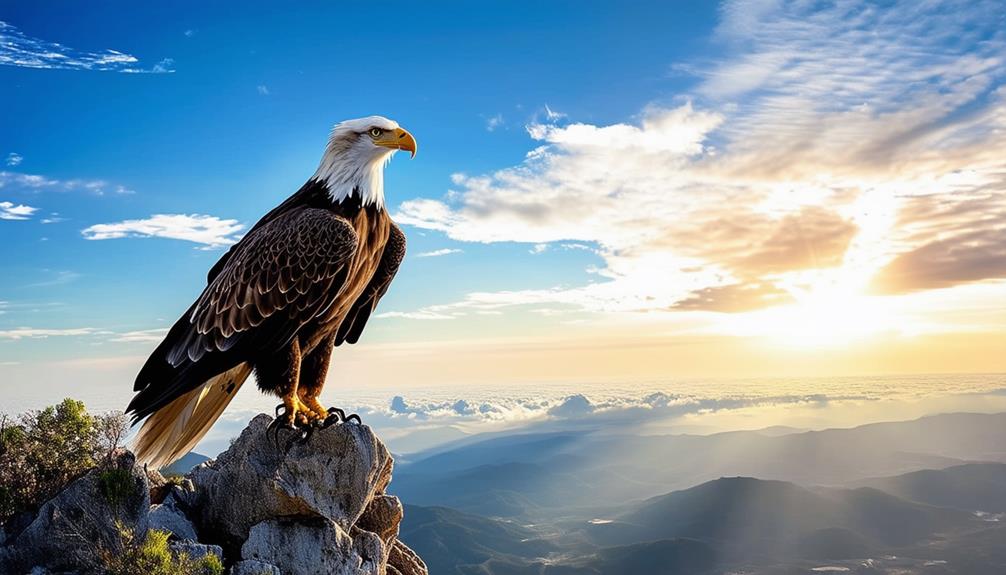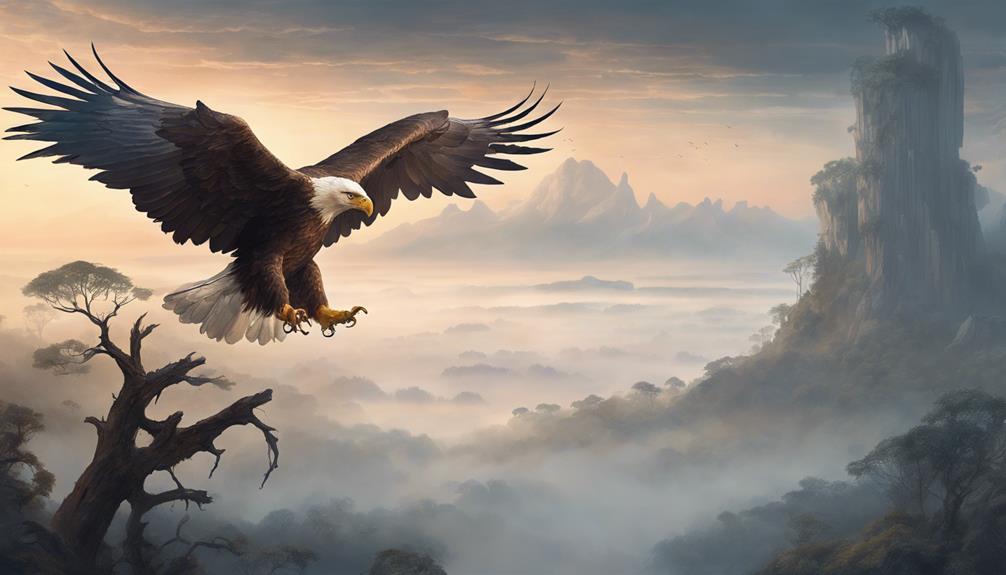
Animal Symbol of Freedom: Exploring the Majestic Eagle
As you gaze upon the majestic eagle's powerful wingspan and piercing gaze, you can't help but feel a sense of awe and reverence. This regal bird embodies the essence of untamed power, courage, and unwavering vision, making it the ultimate symbol of freedom. With its impressive length of up to 38 inches and wingspan of 7 feet, the eagle dominates the skies, exuding strength and authority. As you explore the eagle's domain, you'll uncover its cultural significance, from its revered status in Native American cultures to its iconic presence on the Great Seal and American flag, inspiring ideals of liberty and justice. Prepare to soar into the world of this magnificent creature, where freedom and strength take flight.
Majestic Eagle Characteristics
As you observe the majestic eagle, you'll notice its striking physical characteristics, which set it apart from other birds of prey. Measuring 28-38 inches in length, with a wingspan of up to 7 feet, this bird exudes strength and power.
The distinct white head and tail feathers contrast beautifully with its dark brown body, giving it an air of regality. But what truly makes the eagle majestic is its sharp eyesight, capable of spotting prey from miles away. This exceptional vision, combined with its hunting prowess, makes it a formidable predator.
You can't help but be in awe of its dominance in the skies. As you gaze into its piercing eyes, you sense a deep connection to the natural world. The eagle's majestic presence seems to embody the essence of freedom and wildness.
Its very existence is a reminder of the beauty and wonder that lies just beyond our reach.
Symbolism and Cultural Significance
Beyond its awe-inspiring physical presence, the majestic eagle's cultural significance runs deep, with its image and symbolism woven into the fabric of human history and identity. As you explore the world of eagles, you'll uncover that this regal creature has been a symbol of power, courage, and vision across diverse cultures.
Here are some fascinating examples:
- In the United States, the bald eagle serves as the national symbol, embodying strength, freedom, and patriotism.
- In Native American cultures, eagles are revered as spirit animals, associated with strength, wisdom, and spiritual growth.
- In Greek, Roman, and Norse mythologies, the eagle represents power, courage, and vision, often linked to gods and heroes.
- The bald eagle's image is featured on the Great Seal and American flag, embodying the nation's values and history.
As you reflect on the eagle's cultural significance, you'll realize that its majestic presence continues to inspire pride, ideals of liberty, and justice. With its rich history and symbolism, the eagle remains an enduring symbol of freedom and resilience in American heritage.
Habitat and Ecological Importance

You'll find eagles thriving in diverse environments, from rugged mountains to dense forests, open plains, and coastal regions. As the national bird of many countries, they're an integral part of their surroundings.
In these habitats, eagles play a vital role in maintaining ecosystem balance by regulating prey populations. Their exceptional hunting skills not only provide sustenance but also contribute to seed dispersal, indicating the health of their ecosystems.
As apex predators, eagles are a cornerstone species, and their presence has a ripple effect on the entire ecosystem. Their scavenging habits, often misunderstood, are crucial in cleaning up carcasses and preventing the spread of disease.
By studying eagles, scientists gain valuable insights into migration patterns, conservation needs, and the delicate balance of nature. As you explore further into the world of eagles, you'll begin to appreciate the intricate web of relationships they've with their surroundings.
It's a reflection of the majesty and importance of these incredible creatures, and a reminder of our responsibility to protect and preserve their habitats.
Hunting and Nesting Behaviors
In the pursuit of survival, eagles have honed their exceptional hunting skills, allowing them to thrive in diverse environments and fuel their remarkable nesting behaviors. As you imagine yourself soaring through the skies with these majestic creatures, you'll unearth that their hunting prowess is unmatched.
With powerful talons, they can capture prey, including animals heavier than themselves, and swoop down to grab fish right out of the water.
Here are some fascinating facts about eagles' hunting and nesting habits:
- Diverse diet: Eagles feed on fish, snakes, turtles, rabbits, and other birds.
- Apex predators: Their powerful talons enable them to capture prey, even those heavier than themselves.
- Massive nests: Eagles construct nests up to 9 feet wide and 12 feet deep using sticks, stalks, moss, and grass.
- Long-term commitment: They reuse and add to their nests year after year, showcasing their dedication to their nesting sites.
As you explore deeper into the world of eagles, you'll be amazed by their intricate nesting habits and remarkable hunting abilities. Their powerful talons and sharp instincts make them the ultimate predators, and their nests become safe havens for raising young and protection from predators.
Conservation Efforts and Research

Today, conservation efforts are in full swing to protect eagle populations, building on the progress made since the Bald Eagles Protection Act was passed in 1940. You might be surprised to learn that, not too long ago, these majestic creatures were on the brink of extinction.
In the 1970s, DDT contamination posed a severe threat to bald eagle populations, and by the late 1800s, their numbers had drastically declined due to habitat destruction and hunting. Fortunately, conservation efforts paid off, and in 2007, the bald eagle was removed from the Endangered Species list.
Thanks to ongoing research and protection initiatives, you're now more likely to spot these regal birds soaring in the skies. As you gaze up at their majestic forms, keep in mind that their recovery is a tribute to the power of human dedication and conservation efforts.
Spiritual Significance and Guidance
As you admire the physical majesty of eagles, it's just as fascinating to investigate the profound spiritual significance they hold across different cultures and traditions. You may find yourself drawn to the eagle's symbolic power, which transcends its physical strength.
In many mythologies, eagles are depicted as powerful and divine beings, embodying spiritual significance.
Here are a few ways eagles guide you spiritually:
- Divine Guidance: Eagles serve as spiritual guides, offering wisdom and insights for personal transformation and growth.
- Spiritual Growth: Interpreting eagles in dreams signifies a quest for truth, seeking answers, and receiving divine messages that propel you forward.
- Leadership and Strength: As a totem, eagles symbolize leadership, strength, and divine guidance, encouraging you to tap into your inner power.
- Freedom and Intuition: Eagle symbolism encompasses freedom, independence, power, and intuition in spiritual contexts, reminding you to trust your instincts and soar to new heights.
As you reflect on the eagle's spiritual significance, you may find yourself inspired to set off on a voyage of self-discovery and spiritual growth. The eagle's majestic presence serves as a reminder to tap into your inner strength, seek divine guidance, and trust your intuition to navigate life's challenges.
Frequently Asked Questions
What Eagle Is the Symbol of Freedom?
You're wondering what eagle is the symbol of freedom? Well, it's the bald eagle, which has been a powerful representation of liberty and independence in American culture since 1782, proudly featured on the Great Seal.
What Does the Eagle Animal Symbolize?
You're wondering what the eagle symbolizes? Well, it represents power, freedom, and majesty, embodying strength, vision, and clarity, while signifying renewal, keen perception, and profound insight, making it a powerful symbol in diverse cultures.
What Does the Symbol of the Eagle Represent?
You're wondering what the symbol of the eagle represents? Well, it symbolizes power, freedom, and majesty, embodying personal liberty, courage, and the pursuit of dreams, with strength, clarity, and transcendence at its core.
What Animals Represent Freedom?
You're wondering what animals represent freedom? Well, you'll find that horses, butterflies, and doves are all symbols of freedom, just like wolves, lions, and dolphins in different cultures, embodying qualities like courage and resilience.
Conclusion
As you soar through the domains of the majestic eagle, you've unraveled the threads of its symbolic tapestry, woven from freedom, strength, and wisdom.
You've witnessed its regal presence in the skies, its dominance in the wild, and its ancient wisdom in the hearts of cultures.
Now, as you gaze into the eagle's piercing eyes, bear in mind that its symbolism isn't just a reflection of our aspirations, but a call to conserve, to protect, and to honor the wild beauty that inspires us.




